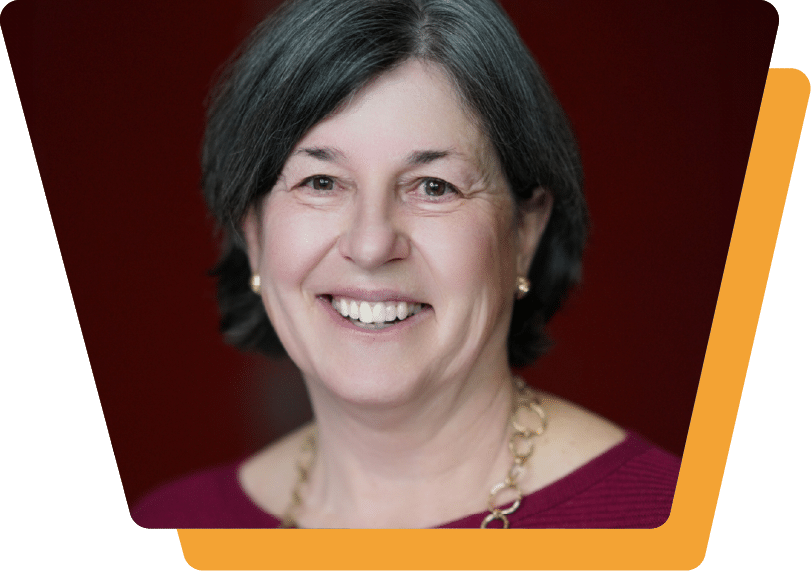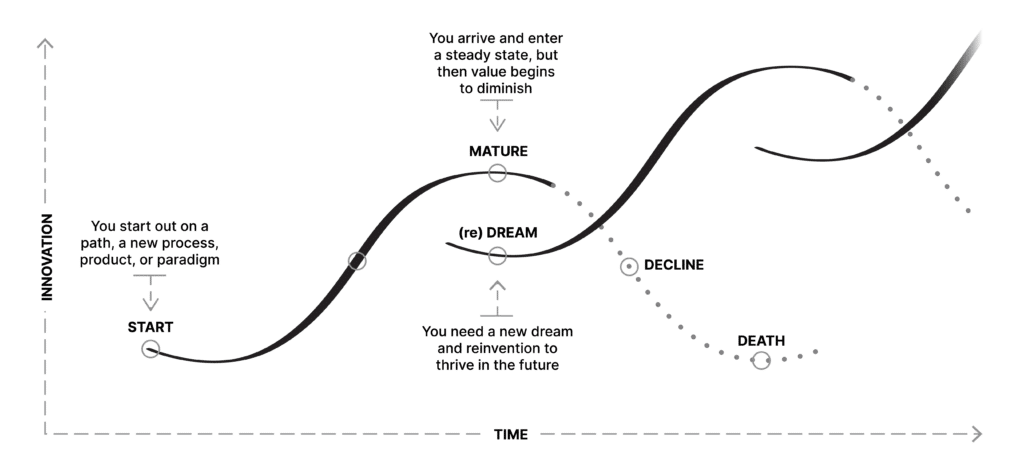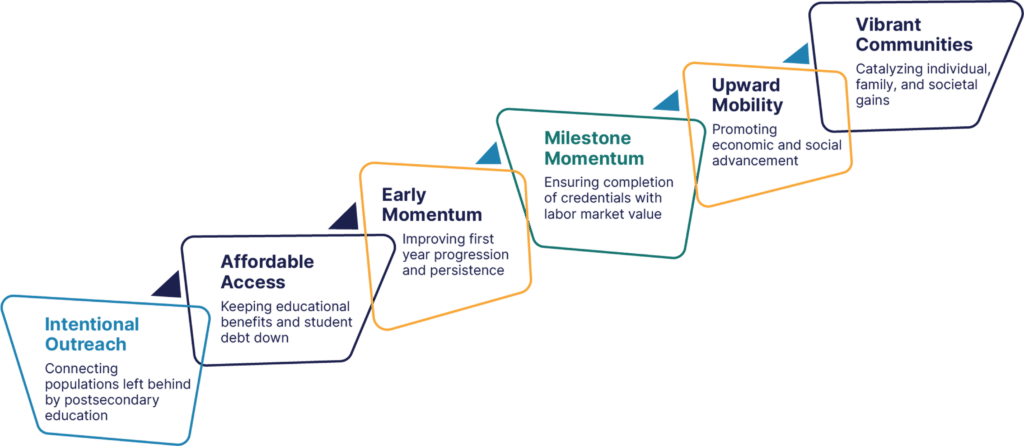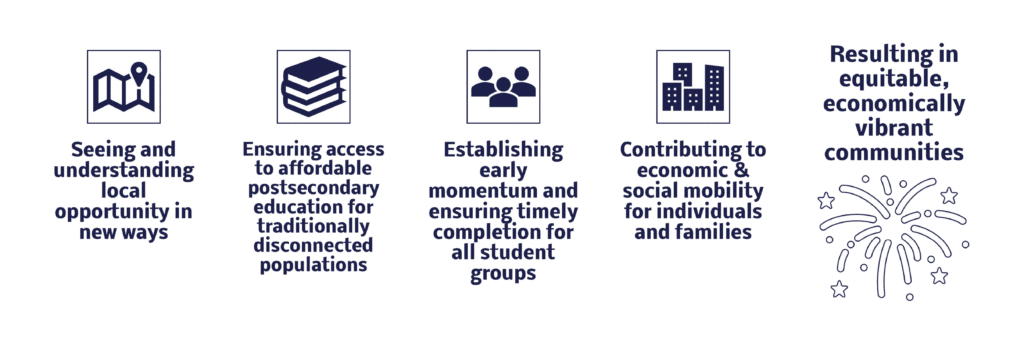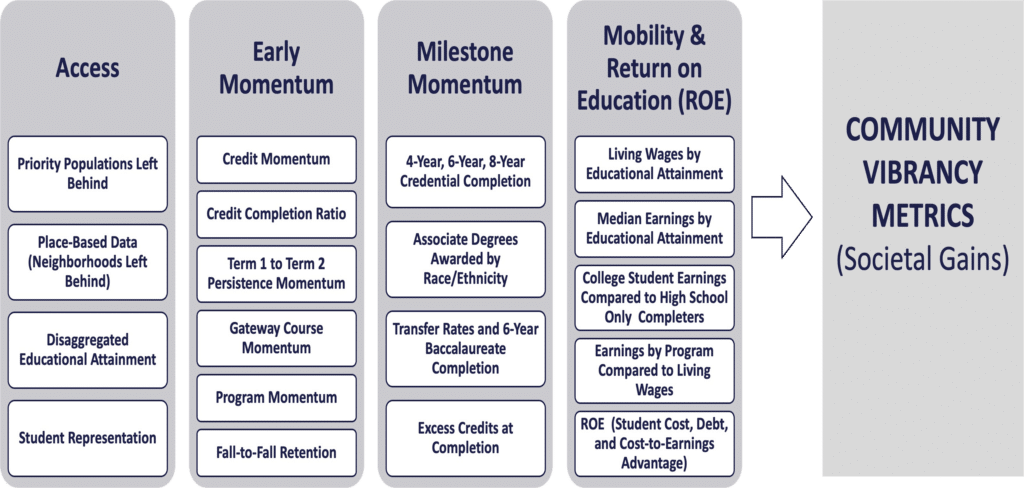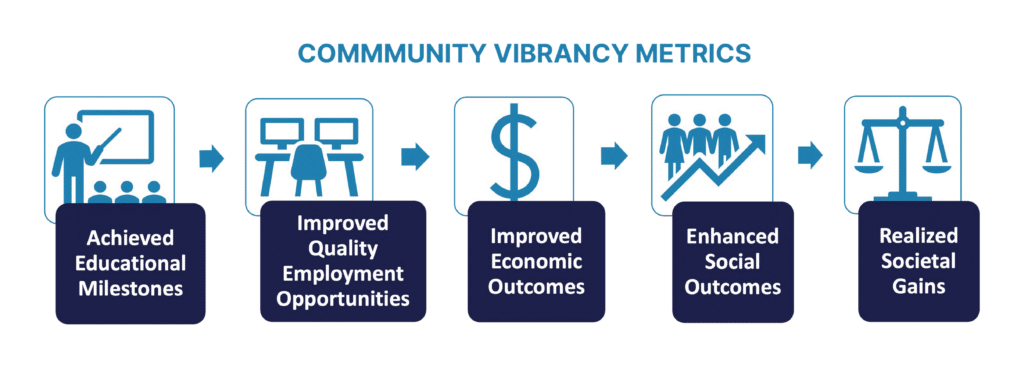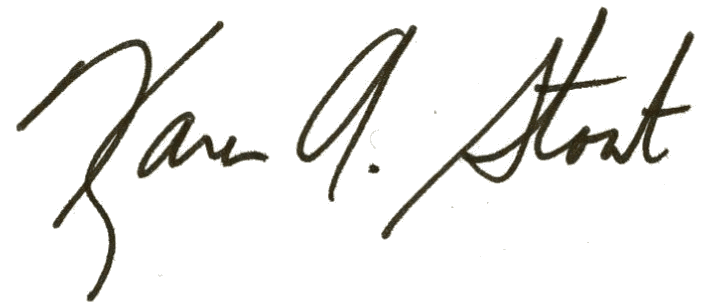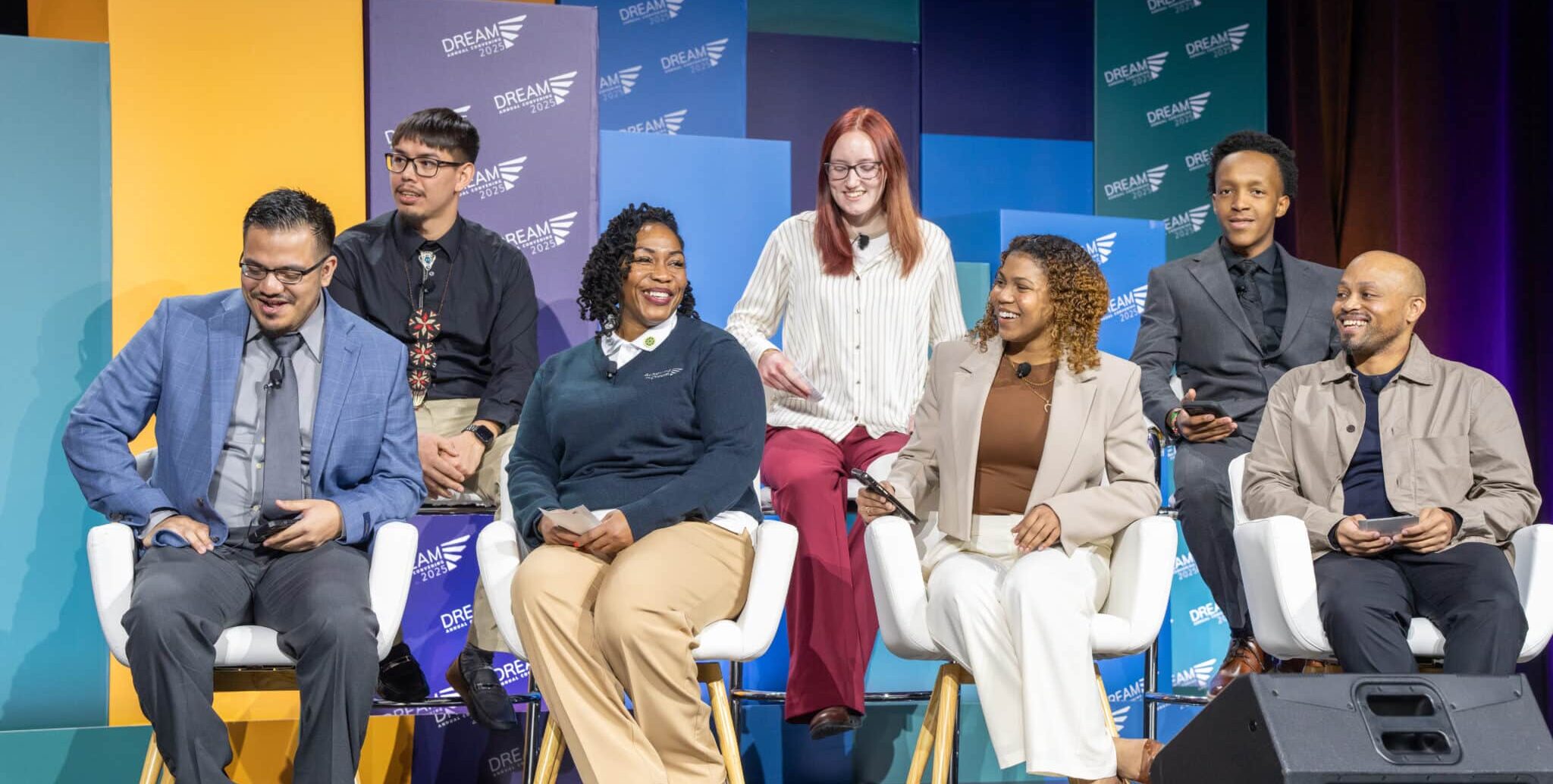The Case for a New Transformative Framework
We’ve been talking this week about imagining a new future. Imagination, like organizations, requires constant feeding. We must continue to dream and reinvent so that we can refine what we are doing, adjust our direction, illuminate the path, and bring others on the journey. Particularly, when the world that sets the context of our work swirls with chaos and uncertainty.
This is the moment to change the narrative about what community colleges are and what higher education as a whole can accomplish. We must anchor our narrative in program and mission to accelerate our transformation and help others see the value of postsecondary education with our sector leading the way. We must both work urgently and take the long view. It is not enough to make our case simply through a moral lens.
In their recent book Practical Radicals: Seven Strategies to Change the World, Deepak Bhargava and Stephanie Luce remind us that seeing movements as part of long cycles can ground us and help us maintain the longer view that is necessary to change, to be adaptive, and to thrive. This is true of the current moment.
Some of you have seen the above illustration before. It comes from Nancy Duarte’s book Illuminate. Successful organizations are in a near constant state of change, growing and sometimes struggling with change, reaching maturity, and re-dreaming so as not to reach decline. Bhargava and Luce remind us that “the time between upsurges isn’t downtime; as there is no end of urgent fights.” We are in that “between” space now.
The student success movement has had this kind of arc that keeps renewing itself.
—
For example, we’ve learned that completion is not the goal, and completion defined narrowly around associate degrees is not sufficient because it leaves out hundreds of thousands of students in important non-degree credential, community college baccalaureate, and transfer completion experiences.
We have learned that completion gains meaning when it is translated directly into a return on education that is tangible to all. Equally significant, the individual return on education must connect to community benefits. Return on education gains larger value as it connects the individual good to the greater good.
And we have learned that access remains fundamental to our work, but it must be more multidimensional than just getting learners into our doors. Access is also what students experience as they move into and through our classrooms and programs and into the community.
As Duarte’s model illustrates, these are not phases of a movement that are completed but rather ones that we continuously reshape to help our students on their own ascents. We are redesigning our redesigns while also moving into the next phases of our climb.
We are at an important juncture. We are collectively at the re-dreaming stage. We know that while we have made progress, it is not enough. We are still leaving too many students, families, and communities behind.
Too many Americans are still not experiencing postsecondary education because of real or perceived barriers. Gaps in attainment still exist that are perpetuated by flaws in our own structures, policies, and practices. We must address our own performance gaps to help students achieve their goals.
College costs are rising, and student loan debt continues to rise. For too many students, completing a college credential does not result in upward economic mobility and it takes too long for them to realize a return on their educational investment. All of this — along with an ongoing attack on higher education — is leading many to question the value of higher education.
Our moment requires a collective embrace of a new guiding structure for our work, one that centers what we have been focusing on for the last decade and connects it with a new way of thinking about access, value, and community impact.
We need a framework that helps colleges look both “inside-out” — deeply understanding students and how transforming institutions supports their success, which has been our focus for many years — and “outside-in” — understanding who is missing from our campuses and how community context influences and informs the work we do to support student success.
We need a framework that holds college and community transformation in mind simultaneously to help community colleges become learning, credentialing, and economic mobility hubs that eliminate inequities in college and workforce outcomes.
ATD’s Community Vibrancy Framework
As a community college advocate and practitioner for 40 years, one thing I am certain of is that as a sector, we hold a mindset of abundance. Abundance is in our DNA and baked into our comprehensive and open-access missions.
We see the challenge not as a shortage of potential learners and workers but rather a shortage of accessible opportunities for more learners and workers to get on a pathway to sustainable careers and purposeful lives. And we can’t wait for them to come to us.
That’s one of the lessons of Dr. Julie White, chancellor of the Pierce College District in Washington, noted as she and her team engaged with us in testing the Community Vibrancy Framework, curriculum, and tools. She said, “If we were serving all the folks in our region who could use advancement and a family-sustaining wage, none of us would have an enrollment problem.”
That’s a big part of what the Community Vibrancy Framework does. It asks: What if we see and understand local opportunity in new ways? Can we ensure access to affordable postsecondary education and build early momentum and timely completion for all students that has value and contributes to economic and social mobility? And in doing all these things, can we also support our communities in flourishing across a broad range of measures?
For Dr. Chris Whaley, president of Roane State Community College in Tennessee, his team’s engagement with the framework helped them begin to answer the big question of the success movement: Success to do what? Ultimately, the college wants to significantly increase the number of people in a community who have economic and social mobility so that they’re lifting up not just a few individuals, but entire communities. Dr. Whaley said, “We can’t do that on our own, but we certainly have an important role and responsibility in that work.”
Pierce and Roane State are two of 15 ATD Network colleges that tested our theory of change alongside the framework, curriculum, and data tools. Their presidents and senior teams were generous in sharing their experiences, aspirations, lessons, and warnings. Their stories offer a new vision for how our student success efforts must move beyond completion to activate the kind of student, institutional, and community transformation that we seek as a sector.
As we dig into the framework, I offer one caveat. Though it may look like a linear, step-by-step process on paper, it is actually a dynamic and interconnected process in which different aspects are implemented simultaneously and in sequences that vary according to each institution’s context.
You can see the outside columns — Access on the left and Mobility and Return on Education on the right — that are “outside-in” in focus and the inside columns — Early Momentum and Milestone Momentum — that are “inside-out” in focus. You can also see the new end game — being high-access and high-mobility colleges for all students — that will, beginning in April, be embedded in the Carnegie Classification system for community colleges.
Seeing Communities in New Ways for a Bold New Access Agenda
Making our institutions boldly and actively accessible becomes fundamental. This begins with seeing our communities through new lenses and being intentional about connecting with the potential students we should be serving but aren’t. To help see communities differently, we need more and better data.
We are going to hear more about that in a bit when Dr. Laura Ullrich from the Richmond Federal Reserve joins us to talk about their powerful Survey of Community College Outcomes. The Community Vibrancy Framework employs a comprehensive set of publicly available data sources to help colleges look at their service areas and regions in new ways.
These data, of course, need to be interpreted with the help of local communities. For instance, when Roane State reviewed data for one county with local leaders, a seemingly high 82% homeownership rate masked the fact that the housing stock was old and not in livable condition because elderly residents, who comprise 20% of the population, could no longer afford the upkeep. Similarly, while data showed that more than a third of 16- to 24-year-olds are not in school and not working, the hidden problem was not dropouts but graduates who lack jobs and never saw postsecondary education in their future.
The data can also be the basis for intentional outreach strategies that can eventually move community impact metrics. At Pierce College, it was the ALICE data that provided a new perspective. ALICE (Asset Limited, Income Constrained, Employed) data focuses on individuals and families who earn above the federal poverty line, but still not enough to afford the basics of housing, child care, food, transportation, health care, and technology. Pierce has prioritized recruitment by expanding outreach to target ZIP codes that have high percentages of families meeting the ALICE criteria. This represents both a population-based and a place-based data approach to reach previously underserved learners and communities.
Dr. Mike Flores, chancellor of the Alamo Colleges District, told us their “oh, wow!” moment came when they were looking at the data for Bexar County and realized the college could provide a pathway to the middle class for more people and release the power of a credential through a single action — expunging the criminal records of students, staff, and others who have been adversely impacted by their involvement with the criminal justice system.
Colleges in the cohort emerged with a new view on access, a view that requires new thinking about ways we design dual enrollment to reach those we are now not reaching as well as new ways to reconnect with adult learners.
We must also continue to find ways to make our institutions as affordable as possible, understanding that perceptions and how we communicate can undermine potential students’ decision-making processes. Dr. Anne Kress, president of Northern Virginia Community College (NOVA), pointed out that most potential NOVA students would pay almost nothing to attend thanks to state and federal programs, but the students still are not coming. She asked, “Why don’t students want a product that we are giving away for free and that has value in future earnings? It’s because it’s inaccessible to them in the way that we’re offering it.”
We cannot communicate to a potential learner or community. We have to be in the community as a trusted partner and with their trusted partners to communicate with them. We have to see access from the perspective of those who have been shut out, which is to say, from the outside in.
Maintaining Momentum
Of course, expanding access is of little value to learners and communities if we do not provide clear pathways that allow learners to move to credentials and jobs in a logical and efficient way, remembering that they are often working and learning simultaneously. This is where we must also lean into what I call “redesigning the redesign.”
For instance, Harper College is sticking to key milestones from previous ATD work and connecting these “inside-out” measures to how students move into and through the college and programs. At Harper, they know that students who meet five key momentum metrics — what they call “the Path to Success” — are three times more likely to graduate than students who don’t.
They are using the Community Vibrancy Framework to build on these and create what Dr. Avis Proctor, president of Harper, described as an “inescapable” student success model for first-year students. The goal, Dr. Proctor said, is “to make sure we do it in a way that is not delivered to small groups of students, but it is comprehensive for all of our first-year students.”
This “inside” work also requires an ongoing commitment to gathering quantitative and qualitative information to know who our students are. That knowledge is key to a continued commitment to providing the right set of holistic student supports inside our institutions and in partnership with key community-based organizations. And it is within the center of the framework that we must bolster our commitment to building a culture of teaching and learning excellence that puts students at the center of the learning experience and connects it with what is relevant and of value in the community.
Promoting Social and Economic Mobility
At a time when people are looking skeptically at college, we need to prove definitively that the learning experience is relevant and leads to better lives. Borrowing language from Fond du Lac Tribal and Community College President Anita Hanson: We need to send the message that all of the programs at our colleges are tied to thriving careers, that each step requires mastering specific skills and knowledge that are part of their programs, and that the college is invested in each student’s success.
Many of the colleges in the Community Vibrancy Cohort are working with students from day one to provide them with greater knowledge of careers that pay a living wage and make career advancement a key focus of advising. Some of our colleges are working with community leaders to improve the economic and social mobility of all who live and work in their service area.
Roane State is working with community leaders across Morgan County, which has some of the highest poverty rates in the state. The college convened 35 county leaders to explore ways to attract new business, enable remote digital jobs, and drive regional economic development. The group is committed to working together to make this happen. “This is the work of a community college,” said President Chris Whaley. “This is the community part of our name.”
Community Vibrancy
The community vibrancy aspect of the framework is what makes it most unique. It moves the ultimate goal from individual benefit to community and societal benefit, from the “I” to the “we.”
This is the nut that Durham Technical Community College is trying to break. You’ll hear from president J.B. Buxton on our panel, but the college already has included in its strategic plan a focus on getting 60% of students to completion and 80% into jobs where graduates earn at least median wages in their fields. When the college leaders delved into the Community Vibrancy Framework, a light went off. They realized that their metrics were missing crucial measures and drivers of institutional success that would carry weight in counties the college serves. In President Buxton’s words: “We were determining the success of the individual in college and after college but neglected the third leg of the stool — the cumulative impact of the college’s work in the community.”
Other cohort colleges are also taking a broader view on impact, recognizing that by catalyzing individual and family returns on education, they can influence their communities’ overall vitality.
In rural Southside Virginia, Patrick & Henry Community College used the Community Vibrancy Framework to respond to fast-changing demographic and employment shifts that are reversing the region’s longstanding economic challenges with an emerging advanced manufacturing base. It’s about ensuring that the community will grow even more vibrant as the college expands “our lens of economic mobility, economic viability, and the work we have to do in the community accordingly,” said President Greg Hodges.
Focusing on ‘We’ Metrics
The Community Vibrancy Framework is a new roadmap for community college sustainability, a pathway for ensuring relevance with value, and a redefining moment for what the student success movement is all about. Community Vibrancy does not abandon our founding values, especially around equity and disaggregating data, but requires new dimensions that will anchor and guide ATD’s work going forward.
For example, the capacities included in the updated Institutional Capacity Assessment Tool, which we tested with 15 colleges this past fall, includes new capacities like Organizational Agility, Community Connectedness, and Disciplined Implementation. And ultimately, the successful implementation of the framework rests on standing on our principles around equity and our local definition of that principle.
Bringing this work forward is about reimagining success to reclaim the value of our sector in transforming the lives of our students and our communities. It is essential given the declining public perception of higher education.
Nearly 7 in 10 (68%) Americans (68%) say higher education is heading in the wrong direction. Even though confidence in community colleges is slightly higher, we must work to confront the loss of public confidence and what it represents.
Our sector is the sector that can build back confidence for all of higher education. Elite institutions and their stories are dominating traditional media and shaping public opinion. We must break through, and that requires a multipronged approach.
We must find ways to reach deeper into our communities to reach new local leaders and groups who can tell our stories for us. We also need to tell our stories better — to students, organizations, businesses, and community leaders. Stories are important but so is translating these stories into impact at scale in our communities. And that requires making better use of storyteller allies like the Federal Reserve.
We all need to be thought leaders for a brighter future, boldly sharing our ideas and insights in traditional and, especially, new media. We can’t remain silent about our impact, our students, or our communities.
We must work each day, on the ground in our communities, to break through the social divide in which education has become a focus.
I know this is a large responsibility. But to me, increased access coupled with a keen focus on value — two areas where the Community Vibrancy Framework leans in — will reach the disconnected populations who are most skeptical of higher education and most in need of a pathway to a credential of value for them and their families.
I recently read Robin Wall Kimmerer’s book The Serviceberry: Abundance and Reciprocity in the Natural World. Kimmerer, a 2022 MacArthur Fellow and an enrolled member of the Citizen Potawatomi Nation, makes the case that the economic unit we measure must shift to “we” not “I” metrics. She notes that “all flourishing is mutual.” Community vibrancy metrics are “we” metrics.
“The prosperity of the community grows from the flow of relationships,” she says, holding up the public library, trails, and cultural landscapes as “common resources” that benefit from this flow.
Our challenge going forward is to position community colleges as a “common resource” —something our unique localness makes possible. As Dr. White noted from Pierce’s experience with the framework, we’ve lost the message that education is a public good. It has been replaced, she said, with “a lot of noise and counter narrative.” We demonstrate our public good by implementing and promoting not just a success agenda, but also a new access and value agenda, an agenda that brings to life our long-held values of equity and supporting all of our students to success.
We do this by imagining and activating the future WE want. We can’t control the national narrative. But we can make a difference in our communities as leaders of a better, more vibrant future for our students and their families.
Duarte describes those who lead and embrace change as “torchbearers.” She says: “When you choose to lead, your ability to see the way and illuminate it for others sets you apart. Torchbearers are dreamers, pioneers, and scouts who are energized to light the path for travelers.”
Let’s continue to collectively be torchbearers and light the path for our students and our communities.
Thank you.

